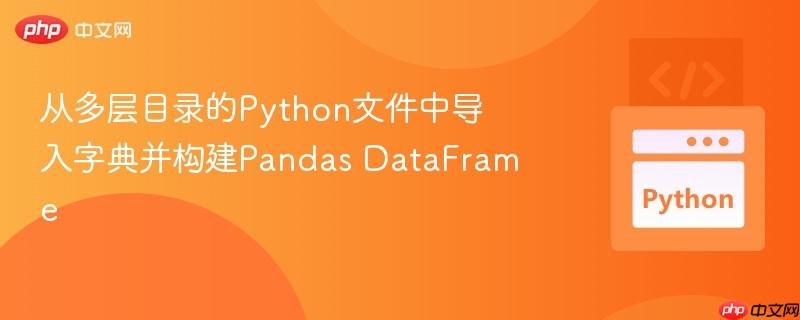
本教程详细介绍了如何从嵌套目录结构中的多个python文件里提取字典数据,并将其整合到一个pandas dataframe中。文章将指导读者使用`os.walk`遍历文件系统,通过文本处理和`ast.literal_eval`安全地解析字典字符串,最终利用pandas库高效地构建和合并数据帧,为处理分散的配置或数据文件提供实用的解决方案。
在许多项目中,我们可能会遇到这样的场景:配置信息、元数据或特定数据片段以Python字典的形式分散存储在多个.py文件中,这些文件可能位于复杂的目录结构中。当需要将这些分散的字典数据统一收集并进行分析时,Pandas DataFrame是理想的数据结构。本文将提供一个专业的教程,指导您如何实现这一目标。
假设您的项目结构如下:
base_directory/
├── module_a/
│ └── sub_module_x/
│ └── form.py # 包含一个字典
└── module_b/
├── sub_module_y/
│ └── form.py # 包含一个字典
└── sub_module_z/
└── form.py # 包含一个字典每个 form.py 文件中都包含一个字典,例如:
# form.py
def_options = {"name": "Alice", "age": 30, "city": "New York"}我们的目标是遍历所有这些 form.py 文件,提取其中的 def_options 字典,并将所有这些字典合并成一个统一的Pandas DataFrame。
立即学习“Python免费学习笔记(深入)”;
首先,我们需要一种机制来遍历指定根目录下的所有子目录和文件,以找到我们感兴趣的 form.py 文件。Python的 os 模块提供了 os.walk() 函数,它能够递归地遍历目录树。
import os
import pandas as pd
import ast # 用于安全地评估字符串为Python对象
# 定义您要搜索的根目录
# 替换为您的实际路径,例如:os.environ["JUPYTER_ROOT"] + "/charts/"
base_directory = "/path/to/your/base_directory"
# 初始化一个空的DataFrame来存储所有字典数据
all_data_df = pd.DataFrame()
# 遍历目录
for root, dirs, files in os.walk(base_directory):
for file in files:
if file.endswith("form.py"):
file_path = os.path.join(root, file)
print(f"找到文件: {file_path}")
# 接下来的步骤将在此处处理文件内容在上述代码中:
找到 form.py 文件后,下一步是从文件中读取其内容并提取字典。由于这些文件是Python脚本,我们不能直接 import 它们(除非它们被设计成可导入的模块,且没有副作用),而是需要将它们作为文本文件来处理。
# ... (承接上文代码)
for root, dirs, files in os.walk(base_directory):
for file in files:
if file.endswith("form.py"):
file_path = os.path.join(root, file)
print(f"正在处理文件: {file_path}")
with open(file_path, "r", encoding="utf-8") as f:
for line in f:
stripped_line = line.strip()
# 假设字典定义在形如 "def_options = {...}" 的单行中
# 并且我们知道字典中包含 "name" 和 "age" 这样的键作为识别依据
if "def_options =" in stripped_line and "name" in stripped_line and "age" in stripped_line:
try:
# 分割字符串,获取等号右侧的字典字符串部分
dict_str_only = stripped_line.split("=", 1)[1].strip()
# 使用 ast.literal_eval 安全地将字符串评估为Python字典
extracted_dictionary = ast.literal_eval(dict_str_only)
# 将提取的字典转换为DataFrame并追加
# 注意:DataFrame([dict]) 会将字典的键作为列名,值作为行数据
temp_df = pd.DataFrame([extracted_dictionary])
all_data_df = pd.concat([all_data_df, temp_df], ignore_index=True)
print(f"成功从 {file_path} 提取字典并添加到DataFrame。")
break # 假设每个文件只包含一个目标字典,找到后即可停止读取当前文件
except (SyntaxError, ValueError) as e:
print(f"错误:无法从 {file_path} 评估字典字符串:{dict_str_only} - {e}")
except IndexError:
print(f"警告:{file_path} 中的行 '{stripped_line}' 格式不符合预期。")
# ... (后续可以打印 all_data_df 或进行其他操作)关键技术点解析:
在每次成功提取字典后,我们将其转换为一个临时的 Pandas DataFrame,然后追加到主 DataFrame 中。
# ... (承接上文代码) # 将提取的字典转换为DataFrame并追加 temp_df = pd.DataFrame([extracted_dictionary]) all_data_df = pd.concat([all_data_df, temp_df], ignore_index=True)
将上述所有步骤整合,形成一个完整的解决方案:
import os
import pandas as pd
import ast
def extract_dicts_to_dataframe(base_directory: str, filename_pattern: str = "form.py", dict_variable_name: str = "def_options") -> pd.DataFrame:
"""
从指定目录下的Python文件中提取字典,并合并成一个Pandas DataFrame。
Args:
base_directory (str): 要搜索的根目录路径。
filename_pattern (str): 要查找的文件名模式,例如 "form.py"。
dict_variable_name (str): 字典在文件中赋值的变量名,例如 "def_options"。
Returns:
pd.DataFrame: 包含所有提取字典数据的DataFrame。
"""
all_data_df = pd.DataFrame()
print(f"开始在目录 '{base_directory}' 中搜索 '{filename_pattern}' 文件...")
for root, dirs, files in os.walk(base_directory):
for file in files:
if file.endswith(filename_pattern):
file_path = os.path.join(root, file)
print(f"处理文件: {file_path}")
with open(file_path, "r", encoding="utf-8") as f:
for line_num, line in enumerate(f, 1):
stripped_line = line.strip()
# 更健壮的字典行识别:检查变量名和等号
if stripped_line.startswith(f"{dict_variable_name} =") and "{" in stripped_line and "}" in stripped_line:
try:
# 分割字符串,获取等号右侧的字典字符串部分
dict_str_only = stripped_line.split("=", 1)[1].strip()
# 使用 ast.literal_eval 安全地将字符串评估为Python字典
extracted_dictionary = ast.literal_eval(dict_str_only)
# 将提取的字典转换为DataFrame并追加
temp_df = pd.DataFrame([extracted_dictionary])
all_data_df = pd.concat([all_data_df, temp_df], ignore_index=True)
print(f" 成功从 {file_path} (行 {line_num}) 提取字典并添加到DataFrame。")
break # 假设每个文件只包含一个目标字典,找到后即可停止读取当前文件
except (SyntaxError, ValueError) as e:
print(f" 错误:无法从 {file_path} (行 {line_num}) 评估字典字符串:'{dict_str_only}' - {e}")
except IndexError:
print(f" 警告:{file_path} (行 {line_num}) 中的行 '{stripped_line}' 格式不符合预期。")
if all_data_df.empty:
print("未找到任何字典或未能成功提取任何字典。")
else:
print("\n所有字典已成功合并到DataFrame中。")
return all_data_df
# --- 使用示例 ---
# 请将此路径替换为您的实际根目录
# 例如:base_path = os.environ.get("JUPYTER_ROOT", ".") + "/charts/"
base_path = "/home/jovyan/work/notebooks/charts/" # 示例路径
# 模拟创建一些文件用于测试 (可选)
# import pathlib
# test_dir = pathlib.Path(base_path)
# test_dir.mkdir(parents=True, exist_ok=True)
# (test_dir / "ahc_visits" / "booking_breakdown_per_age_group").mkdir(parents=True, exist_ok=True)
# (test_dir / "ahc_visits" / "booking_breakdown_per_age_group" / "form.py").write_text('def_options = {"name": "Alice", "age": 30, "city": "New York"}\n')
# (test_dir / "another_module" / "sub_folder").mkdir(parents=True, exist_ok=True)
# (test_dir / "another_module" / "sub_folder" / "form.py").write_text('def_options = {"name": "Bob", "age": 25, "city": "London", "occupation": "Engineer"}\n')
# (test_dir / "empty_folder").mkdir(parents=True, exist_ok=True)
# (test_dir / "bad_format" / "form.py").mkdir(parents=True, exist_ok=True)
# (test_dir / "bad_format" / "form.py").write_text('def_options = {"name": "Charlie", "age": 35, "city": "Paris", "occupation": "Doctor"\n') # 缺少 }
result_df = extract_dicts_to_dataframe(base_path, dict_variable_name="def_options")
print("\n最终的 Pandas DataFrame:")
print(result_df)# 优化后的DataFrame构建部分 all_extracted_dicts = [] # ... (在循环中,当成功提取字典后) # all_extracted_dicts.append(extracted_dictionary) # ... # 循环结束后 # if all_extracted_dicts: # all_data_df = pd.DataFrame(all_extracted_dicts) # else: # all_data_df = pd.DataFrame() # 或者其他空DataFrame初始化
本教程提供了一个从嵌套目录结构中的Python文件中提取字典数据并构建Pandas DataFrame的完整解决方案。通过结合 os.walk 进行文件遍历、文本处理技术(如字符串分割)以及 ast.literal_eval 的安全评估,您可以高效地将分散的结构化数据整合到统一的DataFrame中,为后续的数据分析和处理奠定基础。在实际应用中,请根据您的具体文件格式和安全性需求,调整字典识别和错误处理逻辑。
以上就是从多层目录的Python文件中导入字典并构建Pandas DataFrame的详细内容,更多请关注php中文网其它相关文章!

每个人都需要一台速度更快、更稳定的 PC。随着时间的推移,垃圾文件、旧注册表数据和不必要的后台进程会占用资源并降低性能。幸运的是,许多工具可以让 Windows 保持平稳运行。

Copyright 2014-2025 https://www.php.cn/ All Rights Reserved | php.cn | 湘ICP备2023035733号